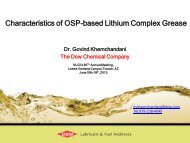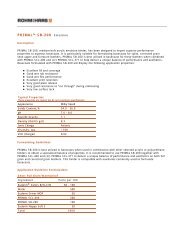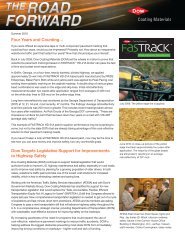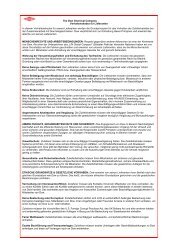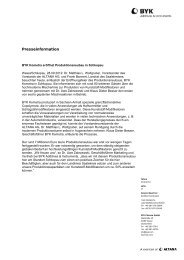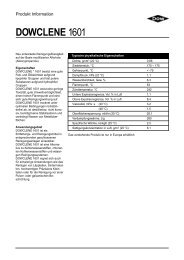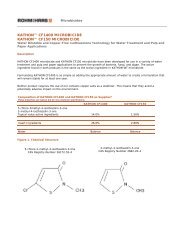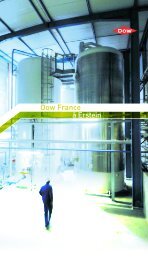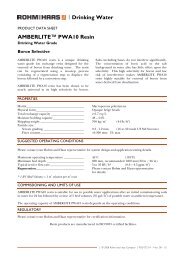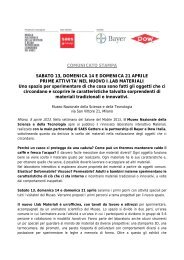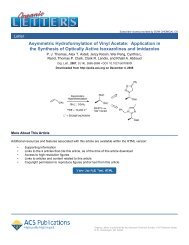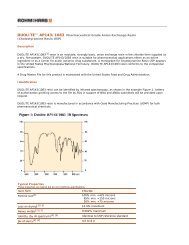776-00301 TYRIN IM bro - The Dow Chemical Company
776-00301 TYRIN IM bro - The Dow Chemical Company
776-00301 TYRIN IM bro - The Dow Chemical Company
You also want an ePaper? Increase the reach of your titles
YUMPU automatically turns print PDFs into web optimized ePapers that Google loves.
PVC Modification<br />
Polyvinyl-chloride (PVC) is an outstanding<br />
material for the production of rigid extruded<br />
goods, such as pipes or profiles. However<br />
due to its high glass transition temperature,<br />
it has shortcomings in impact strength. It has<br />
therefore to be modified to provide impact<br />
strength at ambient and low temperature.<br />
Impact modifiers provide PVC compounds a<br />
consistently ductile behaviour over a <strong>bro</strong>ad<br />
temperature range. <strong>The</strong>y are flexible materials<br />
which are partially compatible with PVC.<br />
<strong>The</strong>y form a discrete phase in the PVC matrix,<br />
which absorbs and dissipates shock energy.<br />
During suspension polymerization of PVC grain<br />
particles with a typical diameter of 65-150<br />
microns are formed. (Figure 1). <strong>The</strong>se consist<br />
of smaller particles ranging from 0.2 to 1.5<br />
microns in size: the primary particles. When<br />
the PVC powder is being processed into a<br />
fabricated product (e.g. by extrusion, calendering)<br />
the grain structure is <strong>bro</strong>ken down<br />
mainly by shear and the primary particles are<br />
molten together at their surfaces.<br />
<strong>The</strong> dominant factor in controlling the<br />
degree of fusion is the melt temperature<br />
and the additive package, consisting of<br />
stablizers, lubricants, fillers, and impact<br />
modifiers can affect the range of processing<br />
conditions required for optimum impact<br />
strength. This process is called fusion or<br />
gelation. <strong>The</strong> achieved impact strength is<br />
controlled by the degree of fusion of the<br />
PVC matrix. An under fused or over fused<br />
melt lowers the impact strength of the<br />
final product.<br />
Trademark of <strong>The</strong> <strong>Dow</strong> <strong>Chemical</strong> <strong>Company</strong> (“<strong>Dow</strong>”) or an affiliated company of <strong>Dow</strong><br />
Essentially two classes of impact modifiers<br />
exist, which are physically blended with s-PVC<br />
during extrusion on twin screw extruders.<br />
Acrylic based modifiers are often used,<br />
which are core-shell particles of typically a<br />
butyl-acrylate flexible core with a rigid shell<br />
of poly-methyl-methacrylate. <strong>The</strong> shell<br />
enables a good flowability of the product<br />
and a good compatibility to PVC to enable a<br />
good dispersion.<br />
<strong>TYRIN</strong> Chlorinated Polyethylene (CPE) is a<br />
thermoplastic material and its morphology<br />
will develop during the melt processing of<br />
the PVC dry-blend. <strong>TYRIN</strong> CPE and other low<br />
melting ingredients will coat the PVC particles.<br />
Figure 1: Primary particles structure of s-PVC<br />
65-150 Micron<br />
During subsequent extrusion a phase inversion<br />
occurs and creates discrete CPE particles in a<br />
continuous matrix of PVC.<br />
<strong>TYRIN</strong> CPE offers an excellent combination of<br />
compatibility, processibility, weatherability,<br />
and impact efficiency in many rigid PVC formulations,<br />
like window profiles, pipes, rigid<br />
and foamed sheet, etc. <strong>The</strong> use of <strong>TYRIN</strong> CPE<br />
makes it possible to use higher filler levels<br />
because being thermoplastic in nature, it<br />
flows and encapsulates inorganic filler particles.<br />
This coating provides a mechanism to<br />
control the particle adhesion to the PVC<br />
matrix and thus improves the contribution to<br />
impact resistance, whereas the filler aids<br />
<strong>TYRIN</strong> dispersion.<br />
Primary<br />
Particles<br />
Skin<br />
Grain<br />
3 of 9



